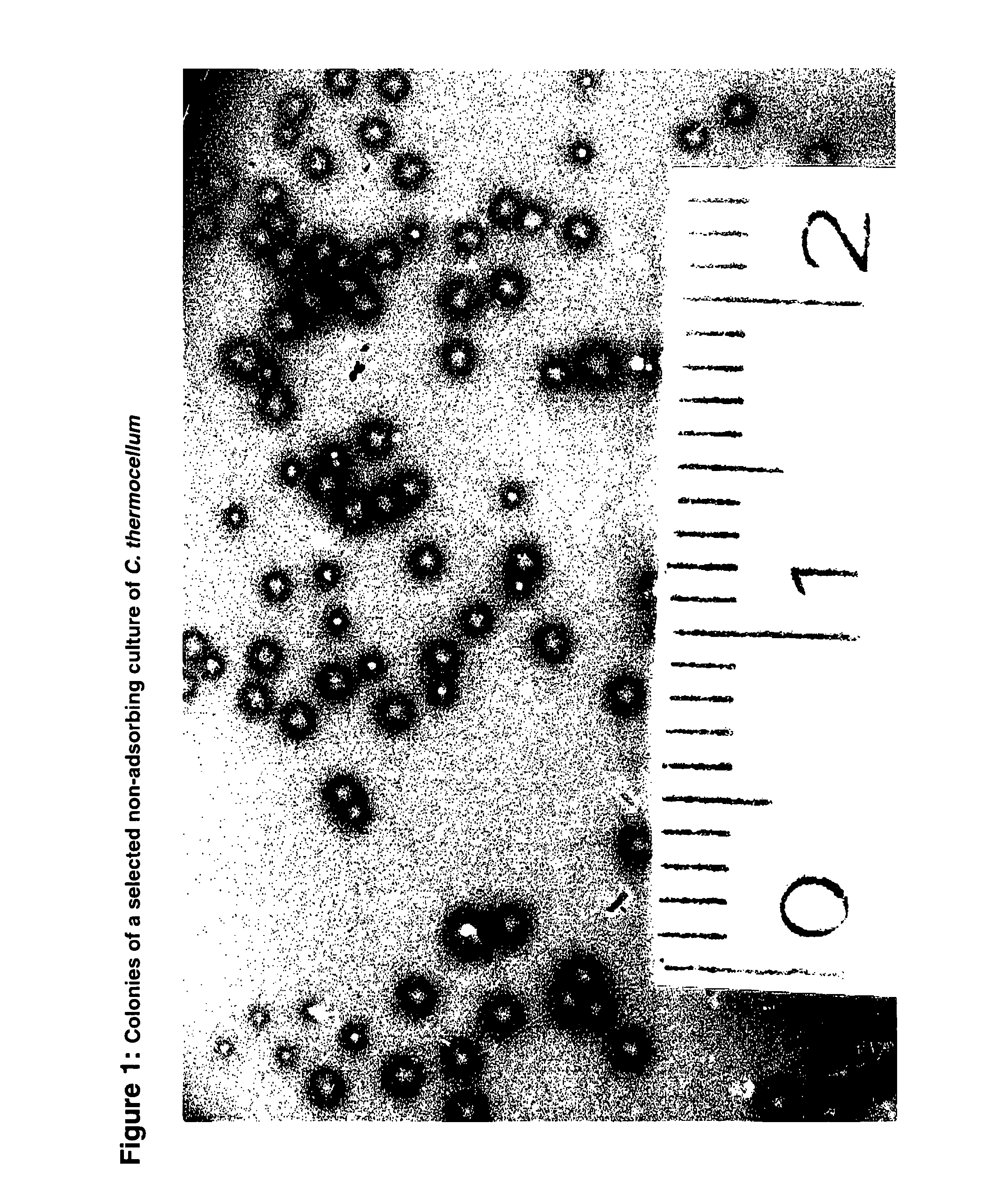Artificial cellulosome and the use of the same for enzymatic breakdown of resilient substrates
a technology of resilient substrates and cellulosomes, which is applied in the direction of enzymology, biofuels, enzyme stabilisation, etc., can solve the problems of cellulose being a recalcitrant material, refractory both, and crystals not being perfectly structured, etc., to achieve enhanced activity of such an enzyme system, and higher activity on crystalline surfaces
- Summary
- Abstract
- Description
- Claims
- Application Information
AI Technical Summary
Benefits of technology
Problems solved by technology
Method used
Image
Examples
example 1
Isolation of a Non-Cellulosome-Forming Mutant
[0095]From mutagenized cultures of C. thermocellum mutants were isolated (FIG. 1). Six colonies with a reduced or absent ability to form clear halos in the cellulose around the colonies were randomly selected. One of the C. thermocellum mutants, SM1, had completely lost the ability to produce the scaffoldin protein CipA or an active cohesin. Enzymes from wild type (having cellulosomes) and mutant SM1 (no cellulosomes; free enzymes) were tested on barley β-glucan, CMC (both control), and micro-crystalline cellulose MN300. The enzymatic activity on barley β-glucan and CMC were about 8.5 and 1.0 U mg−1 protein respectively for both strains (Table 1). In contrast, specific activity on crystalline cellulose was dramatically reduced in the mutant SM1, up to 15 fold as compared to the wild type.
[0096]The mutant produced the cellulosomal components in approximately equal amounts compared to the wild type, with the exception of the CipA component ...
example 2
Reconstitution of the Cellulosome
A: Preparation of Enzyme Components
[0097]The mutant SM1 and the mutant supernatant proteins (SM901) were selected to reconstitute an artificial cellulosome. In addition, genes coding for cellulase components were cloned and characterized for their biochemical parameters such as pH and temperature optimum and activity on different substrates. The five most prominent enzyme components with cellulase activity were selected from previous data on the composition of the cellulosome11. In addition, β-glucosidases derived from a number of thermophilic saccharolytic bacteria were biochemically characterized. The β-glucosidase BglB from Thermotoga maritima was selected due to its high thermostability and high activity on cellodextrins. The gene was fused to a downstream dockerin module from C. thermocellum cellulase CelA. Optimal expression conditions were determined. The enzymes containing catalytic and non-catalytic modules including a dockerin module formed...
example 3
Activity of the Artificial Cellulosome Complex
[0104]A mixture of such complexes with and without CBMs were now bound via an optimized aliphatic linker molecule on the surface of polystyrene nano-particles. Such structures are schematically shown in FIG. 3. The binding of various mini-scaffoldin complexes on hydrolysis of crystalline cellulose resulted in an increase in activity despite the sterical hindrance and a certain loss of degree of freedom of the enzyme components due to the dense covering of the nanoparticles (FIG. 3, 4). In addition, the pH range of the enzymes was broader if the proteins were bound to the particle (FIG. 5). This was also true for the temperature stability of the cellulases (FIG. 6). Both of these results are an important advantage for technical application.
[0105]To test the feasibility of that approach, a part of the SM901 component mixture was replaced by one or more of the recombinant cellulases. Despite the decrease of SM901 components in the mixture, ...
PUM
| Property | Measurement | Unit |
|---|---|---|
| molar ratio | aaaaa | aaaaa |
| diameter | aaaaa | aaaaa |
| mean diameter | aaaaa | aaaaa |
Abstract
Description
Claims
Application Information
 Login to View More
Login to View More - R&D
- Intellectual Property
- Life Sciences
- Materials
- Tech Scout
- Unparalleled Data Quality
- Higher Quality Content
- 60% Fewer Hallucinations
Browse by: Latest US Patents, China's latest patents, Technical Efficacy Thesaurus, Application Domain, Technology Topic, Popular Technical Reports.
© 2025 PatSnap. All rights reserved.Legal|Privacy policy|Modern Slavery Act Transparency Statement|Sitemap|About US| Contact US: help@patsnap.com



